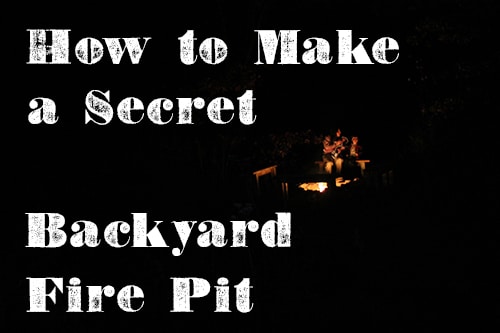
When Kate and I bought our first house two years ago, one of its biggest selling points was that it sits on a little over an acre of land. That may not sound like much if you live out in the country, but in suburban Tulsa, it’s like having a small farm.

The view from our back deck.
Most of the land is in the backyard, where there’s a woodlot consisting primarily of oak and a few maples and redbuds. Our acre backs up into another wooded tract, so there’s a good bit of forest out there. Ever since we moved in, I have wanted to create a trail that led from the house all the way to the back of our property. At the end of the trail, I wanted to make a secret fire pit where I could go and ponder manful thoughts while poking a crackling campfire or enjoying the company of my family (weenie roast!).
I finally got around to working on my trail this fall. It took me about two months to complete. I probably could have finished it sooner, but I usually just had Saturdays to work on it.
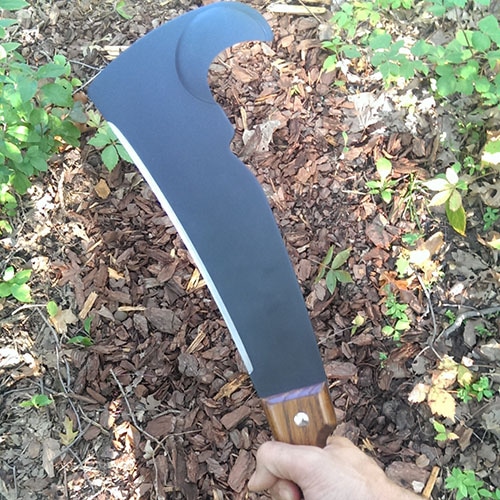
I used a hoe and a Woodman’s Pal to clear the path for my trail. The toughest part of building the trail was when I got past the trees. There’s a spot behind the treeline that’s just a giant briar patch. That crap was a booger to clear. I have the scratches from the thorns to prove it. The Woodman’s Pal was particularly handy here.
After I got the trail path cleared, I made several trips to Home Depot to get bags of pine bark nuggets. I laid those down on my cleared path to keep weeds and other plants from growing back. I think I ended up using over 60 bags of pine bark nuggets. Here are some shots of the completed trail:
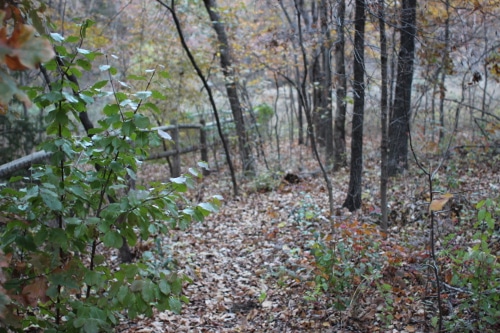
The trail begins. Falling leaves have largely covered up my wood chippage.
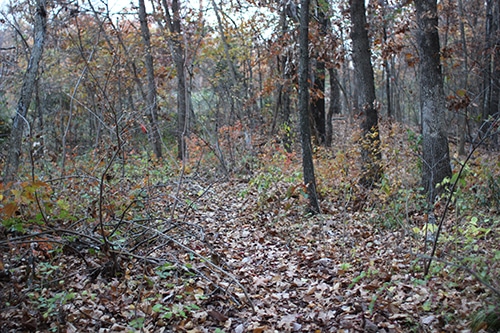
The trail goes up a slight hill.

Top of the hill…
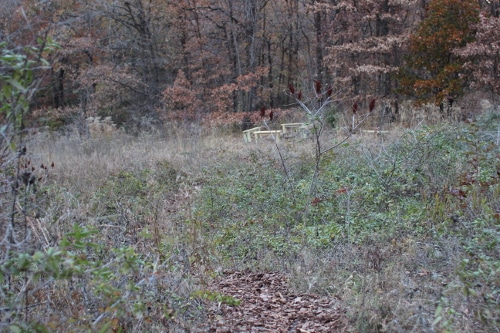
into the briar patch…
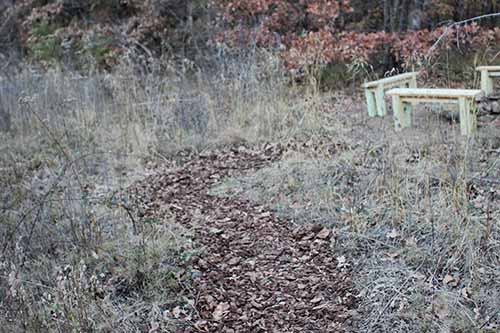
and nearing the secret fire pit…
After I completed my trail, it was time to make my secret fire pit. There are a lot of plans out there for backyard fire pits, but none of them appealed to me. They all look like those foo-fooey, sleek and modern suburban “fire features” you see on HGTV backyard renovation shows. I didn’t have the time, nor did I want to spend the money on something like that. Besides, it’s not my style. I wanted my backyard campfire to look like something you’d stumble upon in a state park — rugged, crude, and functional.
I read some basic info on how to safely make a campfire area and got at it. Even if you don’t have an acre of woods in your backyard, you could still build a fire pit. But you’ll have to check your local city guidelines to see what’s allowed. And of course, the layout and number of trees/bushes on your property will determine whether or not you can make it “secret.” Here’s how I built mine:
Clear Your Campfire Area

Smokey the Bear recommends clearing a 10-foot diameter circle around your fire pit. You’ll want to remove all grass, leaves, and hanging tree limbs from that 10-foot clearing. You want an area of just dirt. I used a hoe and the Woodman’s Pal to create my fire pit area.
Dig the Fire Pit

Mark out how large you want your fire pit to be and start digging a hole. Your fire pit should be about 1 foot deep. I tried just using a shovel for this part, but found that clawing with my hoe and then hoisting out the loose dirt with my shovel worked better. I actually created my ring with rocks first and then dug. While I was digging, I realized it probably would have been better to first make the hole.
Encircle Pit With Rocks
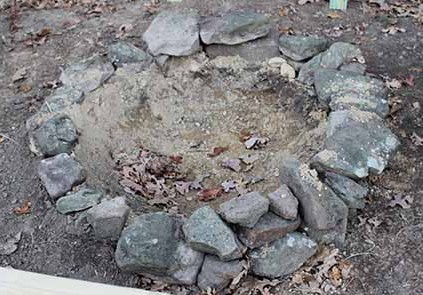
To keep your fire at bay, circle your fire pit with rocks.
The woods behind my house are filled with really hard, yet porous, Oklahoma sandstone rocks. I wanted to use what nature made available to me, but I’ve heard urban legends about campers getting killed by exploding campfire ring stones. Before I gathered my wife and kids around the fire pit, I wanted to make sure the sandstone rocks I planned to use would not assassinate them.
My research on the internet brought up surprisingly little information on exploding campfire rocks. I did find an article on ehow that suggested sandstone and other porous rocks like limestone weren’t safe for fire pits. From the article:
Air- and water-permeable rocks are much more likely to explode than dense non-permeable rocks. This is because air or water is absorbed by the rock when it is cool, and then the air or water molecules trapped inside the rock expand faster than the solid rock when it heats up next to the fire . If there is a high enough volume of water in a hot, porous rock, the rock will explode when the force of the expanding steam gas inside is greater than the rock can contain.
Well, that put a damper on using my bounteous sandstone supply.
But it was an article on ehow. How reliable could it be? So I took to Twitter looking for an honest-to-goodness geologist for an answer. Enter Mark Benson. His response was that most stones are safe for fire pit use provided that they’re not sopping wet. According to Mark, as long as your rock is hard, dry, and has a uniform color and grain you can use it for a fire pit perimeter. So my sandstone rocks were a-okay after all. Mark did suggest that you avoid using chalks and limestones because the heat from the fire will cause the calcium carbonate to break down. He also recommended not using rocks with voids or crystals in the middle. So no geode fire pit rings I’m afraid.
Assured that my sandstone rocks were fire pit safe, I started gathering. I wasn’t scientific about this. If it was a medium to large stone, I picked it up and hauled it to my fire pit area. I layered the rocks with the big ones on bottom and the smaller ones on top. I filled gaps between the rocks with dirt.
Build Some Crude (But Sturdy) Campfire Benches
You need a place to sit while you bask in the radiant warmth of your backyard campfire. I wanted some simple wood plank benches, so I looked online for some plans. I found plenty of sophisticated ideas — but they required handyman skills above my pay grade. So I just decided to wing it. I drove over to Home Depot, looked at the various types of lumber, and came up with a plan in my head right there on the spot. I was pleasantly surprised with how my impromptu benches came out. Here’s how to make them:
Gather Materials

(4) 18″ 4x4s, (2) 40″ 2x4s, (1) 48″ 2×10, drill, 3-inch screws, wood glue
Materials for One (1) Bench
- (1) 48″ 2×10
- (4) 18″ 4x4s
- (2) 40″ 2x4s
- 20 3″ wood screws (to be safe, go with 3 1/2″ screws)
- Wood glue
- Drill
Because I was just going to leave these out by the fire pit, I tried to make my benches with pressure treated wood in order to prevent termite and fungal damage. Unfortunately, Home Depot didn’t have 2X4s that were pressure treated.
Create Bench Base

Apply wood glue on one end of 4×4.
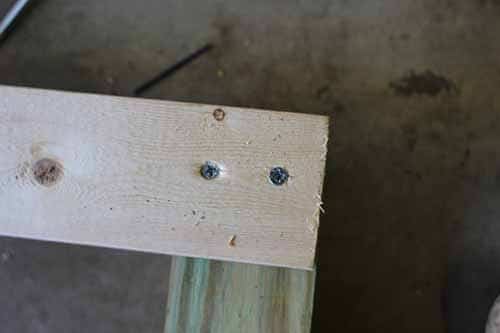
Place one end of the 2×4 onto the glue on the end of the 4X4. Screw in two 3″ wood screws. Repeat process on the other side. That’s one side of your base. Create the second side of your base by repeating the above process.

Screw the two sides of your base together so you get something that looks like the above. I used four 3″ screws in the 2x4s. Two on each side.
Attach Seat to Base
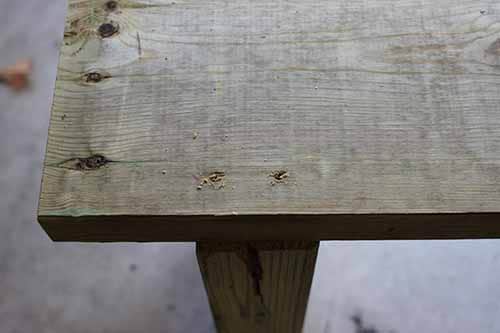
Apply wood glue to the tops of the 4x4s. Place the 2×10 on top of your base. Screw down into each 4×4 leg with two screws.

Finished product. She ain’t purdy, but she’s sturdy.

I made four benches. Hauling them up to the secret fire pit was a workout. Each bench weighs a good 100 pounds. I need to level out my campfire area a bit. The benches are a little wobbly on the uneven ground. I think I might actually bury the legs an inch or two into the ground.
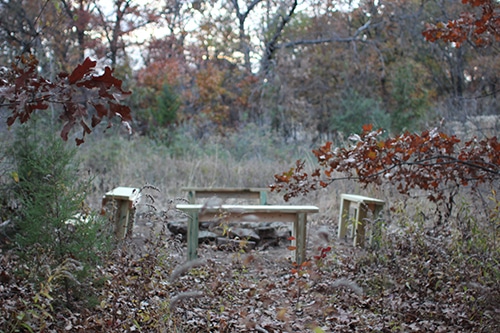
A view looking towards our house. Our fire pit is behind a tree line and can’t be seen by the neighbors either. That’s what makes it “secret.”
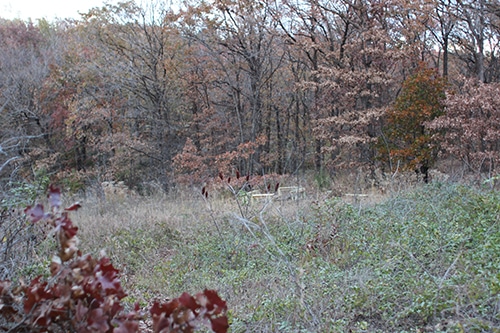
Enjoy Your Backyard Campfire
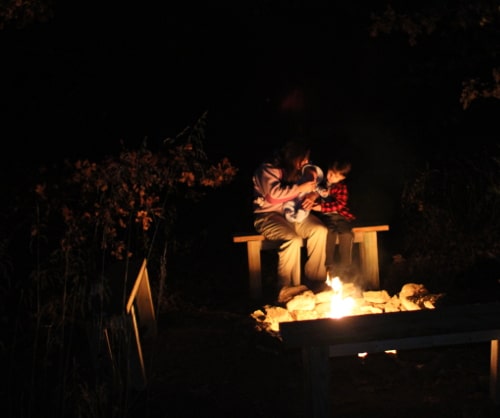
Time to light that fire! Check out our guide to building a campfire to learn how.

I kept this fire small. It was late and kiddos had to get to bed.
Practice Good Campfire Safety
Make sure to fully extinguish your campfire after you’re done — don’t want to burn down the neighborhood! Here’s what Smokey the Bear recommends:
- Allow the wood to burn completely to ash, if possible
- Pour lots of water on the fire, drown ALL embers, not just the red ones
- Pour until hissing sound stops
- Stir the campfire ashes and embers with a shovel
- Scrape the sticks and logs to remove any embers
- Stir and make sure everything is wet and cold to the touch — if it’s too hot to touch, it’s too hot to leave
- If you do not have water, use dirt. Mix dirt or sand with the embers. Continue adding and stirring until all material is cool. Remember: do NOT bury the fire as the fire will continue to smolder and could catch roots on fire that will eventually get to the surface and start a wildfire.
So that’s how I made my secret backyard fire pit. Pretty basic, but you can experiment with the design to your heart’s content. However you do it, you’ll be glad to have a place to retreat to this winter, where you can kindle a fire, stare into the flames, and ponder how to become the best man you can be.


